TomTom 4BA53, 4BA63 User Manual

TomTom GO Basic
User Manual
17.5
Contents
Welcome to navigation with TomTom |
6 |
|
|
What's new |
7 |
|
|
New in this release ................................................................................................ |
7 |
Video workshops ................................................................................................... |
7 |
Get going |
9 |
|
|
Installing in your car .............................................................................................. |
9 |
Positioning the device ............................................................................................ |
9 |
Switching on and off .............................................................................................. |
9 |
Setting up ......................................................................................................... |
10 |
GPS reception .................................................................................................... |
10 |
Sending information to TomTom .............................................................................. |
10 |
Device not starting .............................................................................................. |
11 |
Charging your device ............................................................................................ |
11 |
Finding the memory card slot ................................................................................. |
11 |
Caring for your TomTom GO ................................................................................... |
11 |
What's on the screen |
12 |
|
|
The map view..................................................................................................... |
12 |
The guidance view............................................................................................... |
14 |
The route bar ..................................................................................................... |
15 |
Distances and the route bar ............................................................................... |
16 |
The quick menu .................................................................................................. |
16 |
Navigation buttons............................................................................................... |
17 |
Main Menu smaller buttons and symbols..................................................................... |
18 |
Volume control ................................................................................................... |
20 |
Using gestures .................................................................................................... |
20 |
Changing the text and button size............................................................................ |
21 |
Reordering the Main Menu buttons ........................................................................... |
21 |
Syncing using TomTom MyDrive |
22 |
|
|
About TomTom MyDrive ........................................................................................ |
22 |
Logging in to your TomTom account ......................................................................... |
22 |
Finding and syncing locations using MyDrive ................................................................ |
22 |
Syncing My Places locations with MyDrive ................................................................... |
23 |
Importing a community POI list - MyDrive - NOT CONNECTED ........................................... |
23 |
Deleting a community POI list ................................................................................. |
23 |
Importing a track GPX file...................................................................................... |
23 |
Deleting a track GPX file ....................................................................................... |
24 |
Saving and restoring your personal navigation information .............................................. |
24 |
Using step by step search |
25 |
|
|
About search...................................................................................................... |
25 |
Entering search terms........................................................................................... |
25 |
Working with search results ................................................................................... |
26 |
About postcodes ................................................................................................. |
27 |
List of POI type icons............................................................................................ |
28 |
2 |
|
Planning a route using step by step search |
32 |
|
|
Planning a route to an address ................................................................................ |
32 |
Planning a route to a POI....................................................................................... |
33 |
Planning a route to a city centre ............................................................................. |
35 |
Planning a route to a POI using online search .............................................................. |
37 |
Planning a route using the map ............................................................................... |
38 |
Planning a route using My Places ............................................................................. |
40 |
Planning a route using coordinates using step by step search ........................................... |
41 |
Planning a route in advance ................................................................................... |
42 |
Finding a car park ............................................................................................... |
43 |
Finding a petrol station ......................................................................................... |
45 |
Changing your route |
48 |
|
|
The Current Route menu ....................................................................................... |
48 |
Avoiding a blocked road ........................................................................................ |
50 |
Avoiding part of a route ........................................................................................ |
50 |
Types of route .................................................................................................... |
51 |
Avoiding an incident or route feature using the route bar ............................................... |
51 |
Adding a stop to your route from the current route menu ............................................... |
52 |
Adding a stop to your route using the map ................................................................. |
52 |
Deleting a stop from your route............................................................................... |
52 |
Skipping the next stop on your route ........................................................................ |
52 |
Reordering stops on a route ................................................................................... |
52 |
My Routes |
54 |
|
|
About My Routes ................................................................................................. |
54 |
About GPX and ITN files ........................................................................................ |
54 |
Saving a route .................................................................................................... |
55 |
Navigating using a saved route ................................................................................ |
56 |
Navigating to a stop on a saved route ....................................................................... |
56 |
Adding a stop to a saved route using the map.............................................................. |
58 |
Recording a track ................................................................................................ |
59 |
Navigating using a track ........................................................................................ |
59 |
Deleting a route or a track from My Routes................................................................. |
60 |
Finding the memory card slot ................................................................................. |
60 |
Exporting tracks to a memory card ........................................................................... |
60 |
Importing routes and tracks from a memory card ......................................................... |
61 |
Map Share |
62 |
|
|
About Map Share ................................................................................................. |
62 |
Creating a map change report................................................................................. |
62 |
Creating a map change report from a marked location................................................... |
63 |
Types of map change............................................................................................ |
64 |
Traffic |
66 |
|
|
About RDS-TMC ................................................................................................... |
66 |
The route bar ..................................................................................................... |
66 |
Looking at traffic on the map ................................................................................. |
67 |
Looking at traffic on your route............................................................................... |
68 |
Traffic incidents ................................................................................................. |
68 |
Approaching a traffic jam warning ........................................................................... |
69 |
Avoiding a traffic jam on your route ......................................................................... |
70 |
Advanced Lane Guidance ....................................................................................... |
70 |
|
3 |
Time-dependent speed limits ................................................................................. |
71 |
Speed Cameras |
72 |
|
|
About speed cameras ........................................................................................... |
72 |
Crossing into another area or country ....................................................................... |
72 |
Speed camera warnings......................................................................................... |
72 |
Changing the way you are warned ............................................................................ |
73 |
Updating locations for cameras and hazards ............................................................... |
74 |
Danger Zones |
75 |
|
|
About danger zones ............................................................................................. |
75 |
Crossing into another area or country ....................................................................... |
75 |
Danger zone warnings........................................................................................... |
75 |
Changing the way you are warned ............................................................................ |
76 |
Updating locations for danger zones ......................................................................... |
76 |
My Places |
77 |
|
|
About My Places.................................................................................................. |
77 |
Setting your home or work location .......................................................................... |
77 |
Changing your home location .................................................................................. |
78 |
Adding a location from My Places............................................................................. |
79 |
Add a location to My Places from the map .................................................................. |
79 |
Adding a location to My Places using search ................................................................ |
79 |
Adding a location to My Places by marking ................................................................. |
80 |
Deleting a recent destination from My Places .............................................................. |
80 |
Deleting a location from My Places ........................................................................... |
80 |
Settings |
81 |
|
|
Appearance ....................................................................................................... |
81 |
Display ......................................................................................................... |
81 |
Route Bar...................................................................................................... |
82 |
Guidance view ................................................................................................ |
83 |
Automatic Zoom.............................................................................................. |
83 |
Motorway exit previews .................................................................................... |
83 |
Voices .............................................................................................................. |
84 |
Maps................................................................................................................ |
85 |
Route Planning ................................................................................................... |
85 |
Sounds and Warnings ............................................................................................ |
86 |
Language and Units.............................................................................................. |
87 |
System ............................................................................................................. |
87 |
Help ................................................................................................................ |
88 |
Getting Help |
89 |
|
|
Help ................................................................................................................ |
89 |
Product certification |
90 |
|
|
Finding product certification information on your device................................................ |
90 |
Updating using MyDrive Connect |
91 |
|
|
About MyDrive Connect ......................................................................................... |
91 |
4 |
|

TomTom account ................................................................................................ |
91 |
Setting up MyDrive Connect.................................................................................... |
91 |
Addendum |
93 |
Addendum |
98 |
Copyright notices |
105 |
5

Welcome to navigation with TomTom
This User Manual explains all you need to know about your new TomTom GO Basic navigation device.
To learn about getting started with your device and installing it in your vehicle, we recommend that you read the Get going chapter.
After that, you will probably want to learn about Quick Search and you can read all about that in the Using Quick Search chapter.
For information about what you see on the device itself, go to What's on the screen. To plan your first route, go to Planning a route.
Tip: There are also frequently asked questions (FAQs) at tomtom.com/support. Select your product model from the list or enter a search term.
We hope you enjoy reading about and, most importantly, using your new navigation device!
6

What's new
New in this release
Version 17.1
Advanced Lane Guidance in a split screen
As you approach motorway exits and junctions you can now view map guidance and lane guidance side-by-side in a split screen.
To learn more go to Advanced Lane Guidance in this User Manual.
Quick search and Step by step search
You can now choose between two different ways of searching for an address or a POI. To learn more go to Choosing which search to use in this User Manual.
Read aloud traffic messages
Your device now reads aloud traffic messages about traffic events on your route. To learn more go to Sounds and Warnings in Settings in this User Manual.
Using community POI lists
You can now show your imported community POI lists permanently on the map. To learn more go to Using community POI lists in this User Manual.
Other bug fixes and improvements
Various performance improvements and bug fixes have been implemented.
Video workshops
You can find many videos on our YouTube channel to help you learn about your new TomTom GO Basic and other TomTom products. Visit www.youtube.com/user/TomTomOfficial/videos to find out more!
Tip: Look on the TomTom YouTube Channel for videos in your own language.
Here are links to some videos that you might find interesting:
TomTom GO - playlist of English videos https://www.youtube.com/playlist?list=PLSoQAVympWk79NpmQgjFgigup-UgowFxE
Using MyDrive |
|
UK English: |
https://www.youtube.com/watch?v=PIs5tGFhQIA |
French (France): |
https://www.youtube.com/watch?v=lYpPDxxXSwk |
Spanish (Spain): |
https://www.youtube.com/watch?v=HkZqdD5MkHI |
German: |
https://www.youtube.com/watch?v=Skg6PWMbRxI |
|
7 |
Italian: https://www.youtube.com/watch?v=AybGRzpgu1s
TomTom Sports products https://www.youtube.com/playlist?list=PLSoQAVympWk4DPx3_yMxwHP7cqa17iW6H
8

Get going
Installing in your car
Use the supplied mount to install your TomTom GO Basic in your vehicle. Read the instructions about positioning your device before you install your TomTom GO.
To install your TomTom GO, do the following:
1.Connect the supplied USB cable to the mount. If the mount is integrated into your TomTom GO, connect the USB cable to the device.
Note: Use ONLY the USB cable supplied with your TomTom GO. Other USB cables may not work.
2.Connect the USB cable to the USB car charger and plug this into the power supply on your dashboard.
3.Choose the best smooth location, on your windscreen or side window, to mount your TomTom GO Basic.
Tip: If the mount is integrated into your TomTom GO, you can easily change the rotation of your device. Release the mount from the TomTom GO using the thumb indent. Turn the mount around and clip it back onto the device until you hear it click.
4.Make sure that both the suction cup on the mount and your windscreen are clean and dry.
5.Press the suction cup of the mount firmly against your windscreen.
6.Turn the rubber grip near the base of the mount in a clockwise direction until you feel it lock.
7.If your mount is not integrated into your TomTom GO, place your TomTom GO in the mount, making sure that it clicks into place.
Dashboard adhesive disks are available as part of a range of accessories for your TomTom GO. For more information, go to tomtom.com/accessories.
Positioning the device
Be careful where you install your TomTom GO. The TomTom GO shouldn't block or interfere with any of the following:
Your view of the road.
The controls in your vehicle.
Your rear-view mirrors.
The airbags.
You should be able to reach your TomTom GO easily without leaning or stretching. In a car, you can attach your TomTom GO to the windscreen or side window or you can use a Dashboard Mount Disk to attach the mount to your dashboard.
Switching on and off
Switching your device on
Press the On/Off button until your device starts. If the device was off you see the map view. If your device was sleeping you see the last screen you were looking at.
9
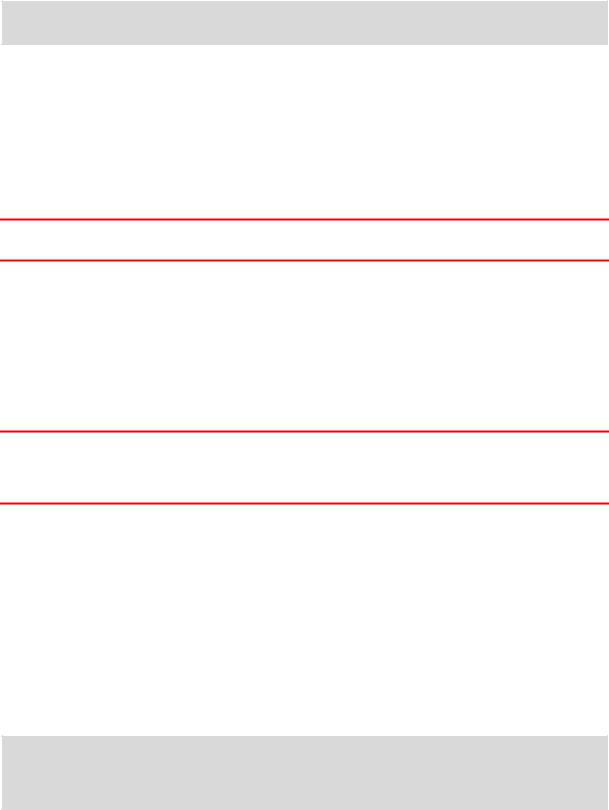
Sending your device to sleep
To send your navigation device to sleep, press the On/Off button and then release it.
You can also press the On/Off button for more than 2 seconds until you see the Sleep and Turn Off buttons. Select Sleep to make the device sleep.
Tip: To send your navigation device to sleep when the USB cable is unplugged or whenever it is removed from the mount, go to Battery settings in the Settings menu.
Switching your device off completely
To switch off your navigation device completely, you can do one of the following:
Press and hold the On/Off button for more than 2 seconds until you see the Sleep and Turn Off buttons. Select Turn Off to switch off the device. Select the "back" button if you don't want to switch your device off.
Press and hold the On/Off button for more than 5 seconds until the device switches off.
Setting up
Note: The language you choose will be used for all text on the screen. You can always change the language later in Language and Units in the Settings menu.
When you first switch on your TomTom GO Basic, you have to answer a few questions to set it up. Answer the questions by touching the screen.
GPS reception
When you first start your TomTom GO Basic, it may need a few minutes to determine your position. In future, your position will be found much faster.
To ensure good satellite reception, use your TomTom GO outdoors and keep it upright. Large objects such as tall buildings can sometimes interfere with reception.
Important: QuickGPSfix contains information about satellite positions which helps your TomTom GO find your position faster. QuickGPSfix information is sent to Always Connected devices in real time and to Smartphone Connected devices when connected to TomTom services using your smartphone. You can also update QuickGPSfix using MyDrive.
Sending information to TomTom
When you first start navigating or you have reset your TomTom GO, your TomTom GO asks for permission to collect some information about your use of the navigation device. The information is stored on your TomTom GO until we retrieve it. We use it anonymously to improve our products and services. If you use our services, we will also use your location information to deliver the services to you.
You can change whether you send this information with us at any time by doing the following:
1.In the Main Menu, select the Settings button.
2.Select System.
3.Select Your information & privacy.
4.Select the button to turn sending of information on or off.
Note: If you choose not to send location information to us, you will no longer receive our services. This is because services need to send the location of your device to TomTom in order to receive the traffic information related to where you are. The end date of your subscription remains the same, even if you do not send this information to us.
You can find current and more detailed information at tomtom.com/privacy.
10

Device not starting
In rare cases, your TomTom GO device may not start correctly or may stop responding to your taps.
First, check that the battery is charged. To charge the battery, connect your TomTom GO device to the car charger. It can take 3 - 5 hours to fully charge the battery depending on the type of device.
Important: Do not charge your device using your vehicle's own USB port because it is not powerful enough.
If this does not solve the problem, you can perform a reset. To do this, press and hold the On/Off button until your TomTom GO begins to restart.
Charging your device
The battery in your TomTom GO Basic charges when you connect it to your TomTom vehicle charger, to your computer or to a USB Home Charger.
Important: Do not charge your device using your vehicle's own USB port because it is not powerful enough.
You are warned when the battery level is low or critical. You lose your connection to some TomTom services when the battery level is low or critical. When the battery is empty, your TomTom GO goes into sleep mode.
Important: On device models START 42/52, START 40/50/60, and GO 51/61, the screen intentionally dims when you connect your device to your computer. The screen also dims if you use a non-TomTom charger that does not provide enough power when charging.
Note: Use ONLY the USB cable supplied with your TomTom GO. Other USB cables may not work.
Finding the memory card slot
The memory card slot is under the mount.
To insert a memory card, release the mount from the TomTom GO using the thumb indent. Insert the memory card into the slot. Clip the mount back onto the device until you hear it click.
Caring for your TomTom GO
It is important to take care of your device:
Do not open the casing of your device under any circumstances. Doing so may be dangerous and will invalidate the warranty.
Wipe or dry the screen of your device using a soft cloth. Do not use any liquid cleaners.
11
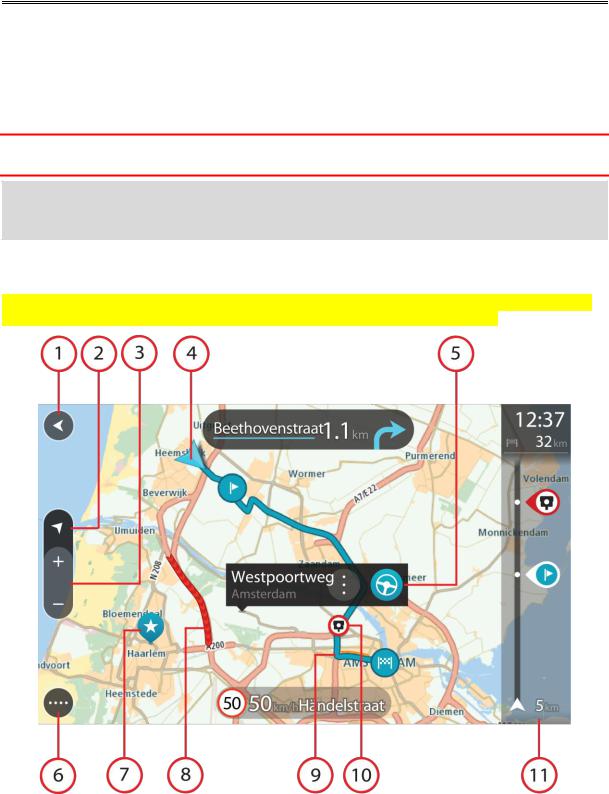
What's on the screen
The map view
The map view is shown when you have no planned route. Your actual location is shown as soon as your TomTom GO has found your GPS location.
You can use map view in the same way as you might look at a traditional paper map. You can move around the map using gestures, and zoom using the zoom buttons.
Important: Everything on the map is interactive including the route and the map symbols - try selecting something and see what it does!
Tip: To open a pop-up menu for an item on the map, for example a route or a POI, select the item to open the menu. To select a location on the map, select and hold the location until the pop-up menu opens.
The map shows your current location and many other locations such as your My Places locations. If you have not planned a route the map is zoomed out to show the area around your location.
If you have planned a route, your complete route is shown on the map. You can add stops to your route directly from the map. When you start to drive, the guidance view is shown.
12
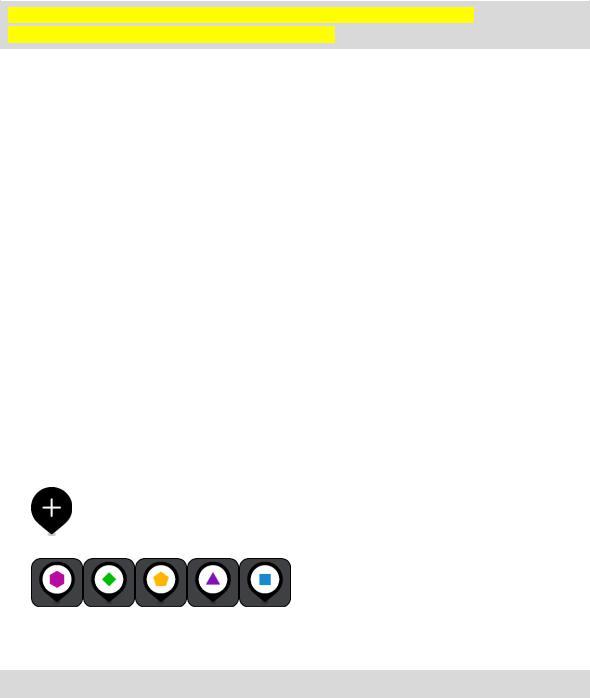
1.Back button. This button returns the map to an overview of your whole route or, if no route is planned, moves the map to put your current location at the centre.
2.Switch view button. Select the switch view button to change between the map view and the guidance view. When in map view, if you are driving, the small arrow rotates to indicate your direction of travel relative to north, with north being up.
3.Zoom buttons. Select the zoom buttons to zoom in and out.
4.Current location. This symbol shows your current location. Select it to add it to My Places or search near your current location.
Note: If your TomTom GO cannot find your location the symbol appears grey. Note: You cannot change the current location symbol.
5.Selected location. Press and hold to select a location on the map. Select the pop-up menu button to show options for the location, or select the Drive/Ride button to plan a route to the location.
6.Main Menu button. Select the button to open the Main Menu.
7.Map symbols. Symbols are used on the map to show your destination and your saved places:
 Your destination.
Your destination.
 Your home location. You can set your home location in My Places.
Your home location. You can set your home location in My Places.
 Your work location. You can set your work location in My Places.
Your work location. You can set your work location in My Places.
 A stop on your route.
A stop on your route.
 A location saved in My Places.
A location saved in My Places.
 A marked location.
A marked location.
When a search for POIs near destination is done and the results are shown on the map, less important POIs are shown as black pins with white crosses.
|
Symbols to show your community POI locations. |
Select a map symbol to open the pop-up menu, then select the menu button to see a list of actions you can take.
8.Traffic information. Select the traffic incident to display information about the traffic delay.
Note: Traffic information is only available if your TomTom GO Basic has TomTom Traffic.
9.Your route, if you have planned a route. Select the route to clear it, change the route type, add a stop or save changes to your route.
1. Speed cameras or danger zones on your route. Select the speed camera or danger zone symbol to display more information.
13
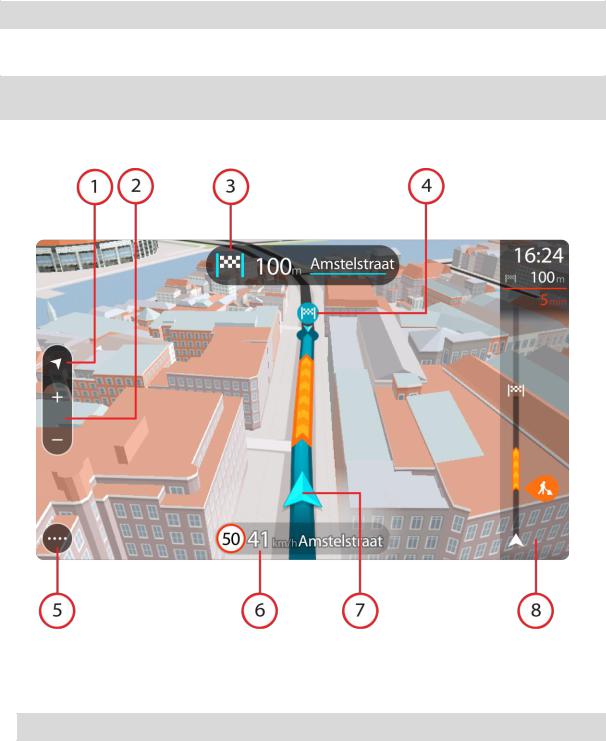
2. Route bar. The route bar is shown when you have planned a route.
The guidance view
The guidance view is used to guide you along the route to your destination. The guidance view is shown when you start driving. You see your current location and details along your route, including 3D buildings in some cities.
Note: 3D buildings in guidance view are not available on all devices.
The guidance view is normally in 3D. To show a 2D map with the map moving in your direction of travel, change the 2D and 3D default settings.
Tip: When you have planned a route and the 3D guidance view is shown, select the switch view button to change to the map view and use the interactive features.
When your TomTom GO starts after sleeping and you have a route planned, you are shown the guidance view with your current location.
1.Switch view button. Select the switch view button to change between the map view and the guidance view. When in guidance view, if you are driving, the small arrow rotates to indicate your direction of travel relative to north, with north being up.
2.Zoom buttons. Select the zoom buttons to zoom in and out.
Tip: On some devices you can also pinch to zoom in and out.
3.Instruction panel. This panel shows the following information:
The direction of your next turn.
The distance to your next turn.
14
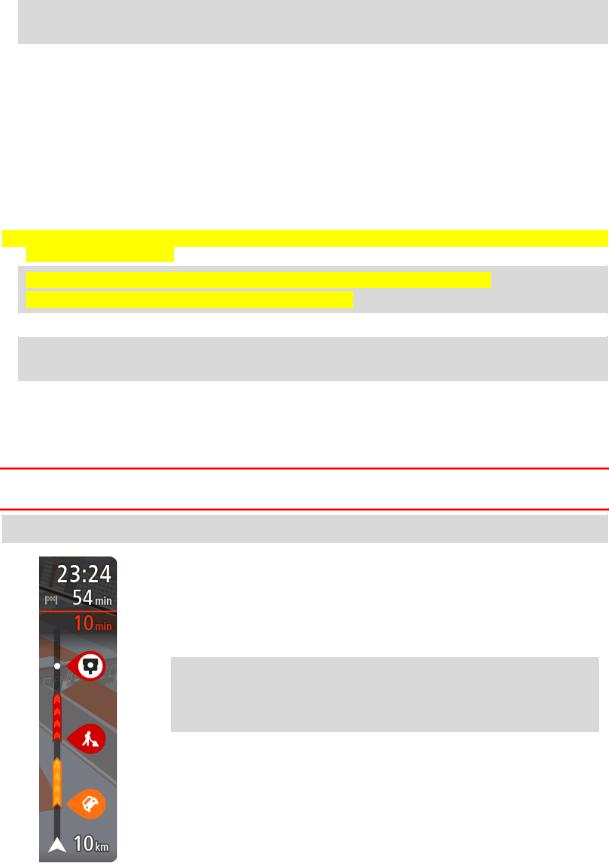
The name of the next road on your route.
Lane guidance at some junctions.
Note: Select the instruction panel to see a list of turn-by-turn text instructions for your planned route.
4.Route symbols. Symbols are used on your route to show your starting location, your stops, and your destination.
5.Main Menu button. Select the button to show the Main Menu.
6.Speed panel. This panel shows the following information:
The speed limit at your location.
Your current speed. If you drive more than 5 km/h or 3 mph over the speed limit the speed panel turns red. If you drive less than 5 km/h or 3 mph over the speed limit the speed panel turns orange.
The name of the street you are driving on.
The speed camera or risk zone report button.
7.Current location. This symbol shows your current location. Select the symbol or the speed panel to open the quick menu.
Note: If your TomTom GO cannot find your location the symbol appears grey. Note: You cannot change the current location symbol.
8.Route bar. The route bar is shown when you have planned a route.
Important: To see a wider route bar showing additional route information, change the setting for Route Information.
The route bar
The route bar is shown when you have planned a route. It has an arrival information panel at the top, and a bar with symbols underneath.
Important: To see a wider route bar showing additional route information, change the setting for Route Information.
Note: The distance ahead shown by the route bar depends on the overall length of your route.
The arrival information panel shows the following information:
The estimated time that you will arrive at your destination.
The length of time to drive to the destination from your current location.
A parking button is shown near the destination flag when parking is available near your destination.
Tip: If your destination is in a different time zone, you see a plus
(+) or a minus (-) sign and the time difference in hours and half hours in the arrival information panel. The estimated time of arrival is the local time at your destination.
If you have stops on your route, select this panel to change between information about the next stop and your final destination.
You can choose the information you see on the arrival information panel. The bar uses symbols to show the following information:
The next two stops on your route.
Petrol stations that are directly on your route.
TomTom Traffic.
15

TomTom Speed Cameras and Danger Zones.
Rest stops directly on your route.
You can choose the information you see on your route.
The symbols are in the order that they occur on your route. For traffic incidents, the symbol for each incident alternates between showing the type of incident and the delay in minutes. Select a symbol to see more information about a stop, an incident or a speed camera. If a symbol is shown on top of another symbol, selecting the symbols zooms in on the route bar to show each symbol separately. You can then select a symbol.
The total time delay due to traffic jams and other incidents on your route, including information provided by IQ Routes, is shown above the symbols.
For a complete list of incident types, see Traffic incidents.
The bottom of the route bar represents your current location and shows the distance to the next incident on your route.
Note: To make the route bar more readable some incidents may not be shown. These incidents will always be of minor importance and only cause short delays.
The route bar also shows status messages, for example Finding fastest route or Playing route preview.
Distances and the route bar
The distance ahead shown on the route bar depends on the length of your route, or the distance remaining on your route.
For remaining distances longer than 50 km (31 miles), only the next 50 km (31 miles) is shown. The destination icon is not shown.
Tip: You can scroll the route bar to see your whole route (not available on iOS).
For remaining distances between 10 km (6 miles) and 50 km (31 miles), the complete distance is shown. The destination icon is shown fixed at the top of the route bar.
For remaining distances of less than 10 km (6 miles) the complete distance is shown. The destination icon moves down towards the chevron symbol as you get nearer to your destination.
The top half of the route bar shows twice the distance of the bottom half, as shown in the following examples:
A remaining distance of 50 km on the route bar is split into 34 km (21 miles) at the top and 16 km (9 miles) at the bottom.
A remaining distance of 10 km on the route bar is split into 6.6 km (4 miles) at the top and 3.3 km (2 miles) at the bottom.
The route bar is constantly updated as you drive.
The quick menu
To open the quick menu, select the current location symbol or the speed panel in the guidance view.
You can then do any of the following:
Mark a location
Change a speed limit
Avoid a blocked road
See your current location or your latitude/longitude if not on a named road.
16
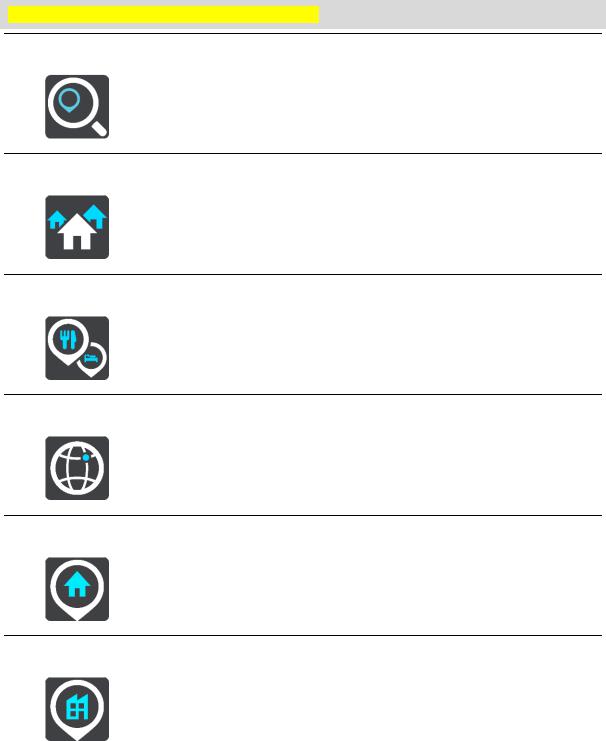
Navigation buttons
On the map view or guidance view, select the Main Menu button to open the Main Menu. The following navigation buttons are available in the Main Menu:
Note: Not all features are supported on all devices.
Drive To |
Select this button to open the Drive To menu to search for an address, a |
|
Point of Interest or a latitude-longitude coordinate, then plan a route to |
||
|
||
|
that location. |
Address |
In the Drive To menu, select this button to search for an address then |
|
plan a route to that location. |
||
|
Point of Interest |
In the Drive To menu, select this button to search for a point of interest, |
|
then plan a route to that location. |
||
|
Latitude Longitude |
In the Drive To menu, select this button to search for a lati- |
|
tude-longitude coordinate, then plan a route to that location. |
||
|
Drive Home |
Select this button to drive to your home location. If this button is not |
|
included in your main menu, go to My Places to set up you home |
||
|
||
|
location. |
Drive to Work |
Select this button to drive to your work location. If this button is not |
|
included in your main menu, go to My Places to set up your work |
||
|
||
|
location. |
|
|
|
17
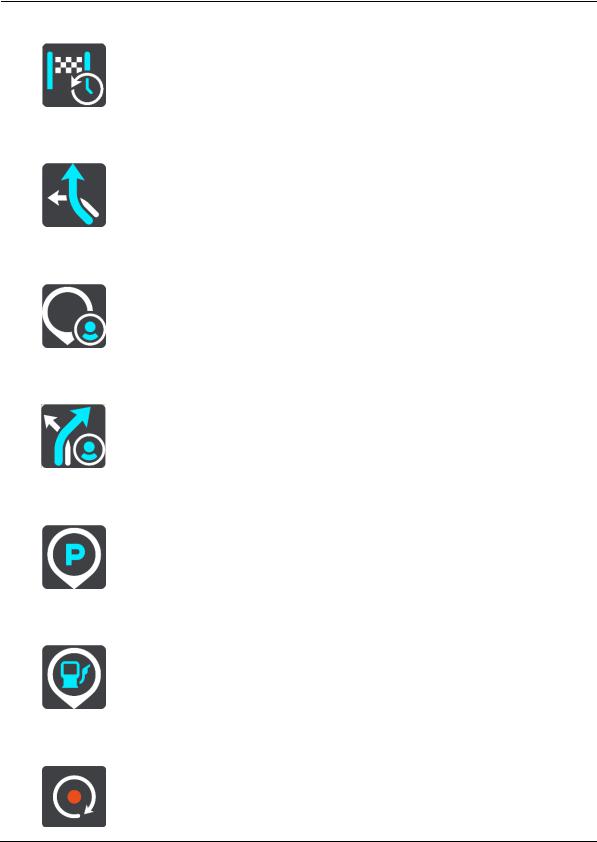
Recent Destination |
Select this button to open the list of your recent destinations. Select a |
|
recent destination to plan a route to that destination. |
||
|
||
|
|
|
Current Route |
Select this button to clear or change your planned route. |
|
|
||
|
|
|
My Places |
Select this button to show your saved places. |
|
|
||
|
|
|
My Routes |
Select this button to show your saved routes. |
|
|
||
|
|
|
Parking |
Select this button to find car parks. |
|
|
||
|
|
|
Petrol Station |
Select this button to find petrol stations. |
|
|
|
|
Start Recording |
Select this button to start or stop recording a track. |
|
|
Main Menu smaller buttons and symbols
On the map or guidance view, select the Main Menu button to open the Main Menu.
18
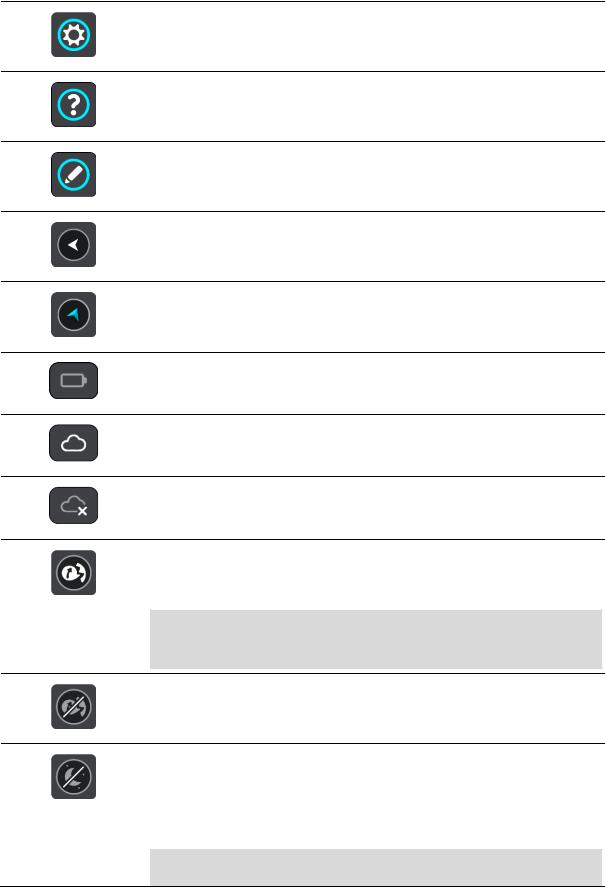
The following buttons are available in the Main Menu screen, in addition to the navigation buttons:
Select this button to open the Settings Menu.
Select this button to open the Help Menu. The Help Menu contains information about your TomTom GO, for example, map version, device serial number and legal information.
Select this button to reorder the buttons in the Main Menu.
Select this button to return to the previous screen.
Select this button to return to the map view or guidance view.
This symbol shows the power level of the battery in your device.
This symbol shows that your TomTom GO is connected to your TomTom account.
This symbol shows that your TomTom GO is not connected to your
TomTom account.
This button shows that you will hear voice instructions. Select this button to switch off voice instructions. You will no longer hear spoken route instructions but you will still hear information such as traffic information and warning sounds.
Tip: You can select the types of instructions you want to hear. Select Voices in the Settings Menu and select the instructions you want to hear.
This button shows that you will not hear voice instructions. Select this button to switch on voice instructions.
This button shows that the display is using day colours. Select the button to reduce the brightness of the screen and display the map in darker colours.
When driving at night or when driving through a dark tunnel, it is easier to view the screen and less distracting for the driver if the brightness of the screen is dimmed.
Tip: Your device automatically switches between day and night colours depending on the time of day. To switch off this feature, select
19

Appearance in the Settings menu and switch off Switch to night colours when dark.
This button shows that the display is using night colours. Select the button to increase the brightness of the screen and display the map in brighter colours.
Select this button to refresh your screen.
Volume control
On the map or guidance view, select the Main Menu button to open the Main Menu.
Select and slide the volume control to change the volume of voice instructions and warnings. If the voice instructions are switched off, the volume control will still change the volume of the warnings.
Using gestures
You use gestures to control your TomTom GO.
In this User Manual, you learn how to use gestures to control your TomTom GO. Below is an explanation of each gesture.
Double tap Touch one finger on the screen twice in rapid succession. Example of when to use this: Zooming in on the map.
Drag |
Put one finger on the screen and move it across the screen. |
|
Example of when to use this: Scrolling around in the map. |
Flick |
Flick the tip of a single finger across the screen. |
|
Example of when to use this: Scrolling a big distance on the map. |
|
|
|
Tip: Flick isn't available on all devices. |
|
|
|
|
Press and hold |
Put one finger on the screen for more than 0.5 second. |
|
Example of when to use this: Opening the pop-up menu for a place on the |
|
map. |
20
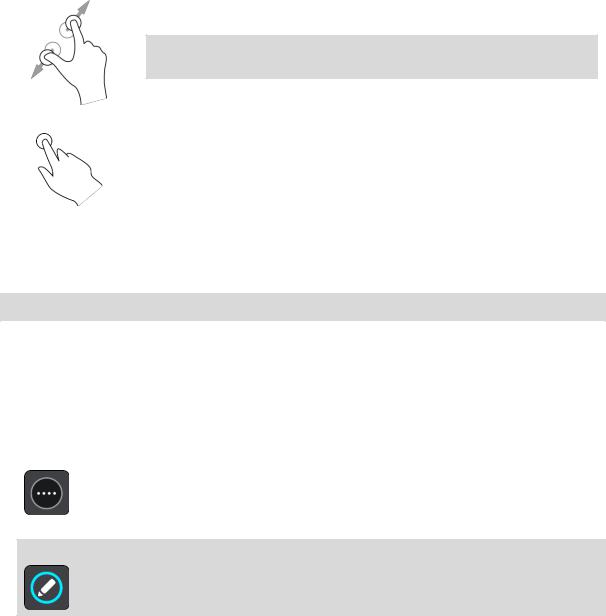
Pinch to zoom Touch the screen with your thumb and a finger. Move them apart to zoom in or move them together to zoom out.
Example of when to use this: Zooming in and out on the map.
Tip: Pinch to zoom isn't available on all devices. If pinch to zoom isn't available, use the zoom buttons to zoom in and out.
Tap or select Tap a single finger on the screen.
Example of when to use this: Selecting an item in the Main Menu.
Changing the text and button size
You can change the size of the text and the buttons you see on the screen, for example to make the text easier to read and the buttons easier to use.
Note: This feature is only available on devices with a 6 inch / 15 cm or larger screen.
To change the size of the text and the buttons, select the Settings button in the Main Menu, then select Appearance, then select Size of text and buttons. Your device must restart to apply the change.
Reordering the Main Menu buttons
To reorder the buttons in the Main Menu to suit your preference, do the following:
1.Select the Main Menu button to open the Main Menu.
2.Press and hold the button you want to move for two seconds.
Tip: Alternatively, select the Edit button in the Main Menu.
The menu button is shown with left and right arrows.
3.Press the left or right arrow on the menu button to move the button to a new position in the menu.
4.Select and move other buttons to the order you want.
5.Select Done.
21

Syncing using TomTom MyDrive
About TomTom MyDrive
TomTom MyDrive is the easy way to import community POI files on your TomTom GO Basic.
Logging in to your TomTom account
You must log in to MyDrive to sync to your TomTom account. When you log in to your TomTom account from your navigation device or when using a web browser, syncing with your account happens automatically.
Logging in to MyDrive on your TomTom GO
1.Connect your TomTom GO to your computer using MyDrive Connect.
2.In the Main Menu on your device, select TomTom Services.
3.Select MyDrive.
4.Enter the email address and password you use for your TomTom account.
5.Select Log In.
Your TomTom GO connects to your TomTom account.
6.Return to the map view.
Your TomTom GO automatically saves your personal navigation information to your TomTom account.
Logging in to MyDrive using a web browser
Log in using your TomTom account email address and password. When you are logged in, you can see your personal navigation information from your navigation devices, and you can select destinations and create Places to sync with your navigation devices.
Finding and syncing locations using MyDrive
When you are logged in to TomTom MyDrive, you can find locations in MyDrive and sync them with your TomTom GO My Places locations.
1.Connect your TomTom GO to your computer using MyDrive Connect.
2.In a web browser, log in to your TomTom account.
3.On the map, select a destination.
Tip: You can search for a destination or you can move the map and select a destination. You can also select a destination from your My Places list.
4.Click on the location, then open the pop-up menu and select Add to My Places. The location is shown in the Favourites list in the MyDrive My Places menu.
5.Log in to MyDrive on your TomTom GO.
Your TomTom GO syncs with your TomTom account and receives the new Favourites location. The location is stored in My Places.
22

Syncing My Places locations with MyDrive
When you are logged in to MyDrive on your TomTom GO, the locations you have added to My Places are automatically synced with your TomTom account. You can see your My Places locations and the POI place lists when you are logged in to MyDrive in a web browser.
Importing a community POI list - MyDrive - NOT CONNECTED
You can find collections of community POIs on the Internet and upload them to My Places using MyDrive in a web browser. A POI collection might contain, for example, campsites or restaurants for the area you are travelling in, and provides an easy way to select a location without the need to search for the location each time.
Your TomTom GO uses .OV2 files for POI collections.
To upload an .OV2 file to your TomTom GO, do the following:
1.Connect your TomTom GO to your computer using MyDrive Connect.
2.In MyDrive, select Import POI File and browse to your .OV2 file.
Tip: The name of the places list in My Places will be the same as the name of the .OV2 file. Edit the name of the file so that you can easily recognise it in My Places.
3.Upload the POI list to your TomTom GO. Your new POI list is shown in the Places list.
4.In My Places, select your new POI list.
Your new POI list opens showing all the POIs in the list. Select the map view to see the POIs on the map.
Deleting a community POI list
You can only delete an uploaded POI list when your TomTom GO is connected to your computer using MyDrive Connect.
To delete a POI list, do the following:
1.Connect your TomTom GO to your computer using MyDrive Connect.
2.In MyDrive, select the POI file you want to delete, then select Delete. The POI list is removed from your My Places list.
Importing a track GPX file
GPX files (GPS exchange format)
GPX files contain a very detailed recording of a route, including any off-road locations. A GPX file might contain, for example, a tourist route or a preferred fixed route. You can find collections of
.GPX files on the Internet and upload them to My Routes using MyDrive in a web browser. GPX files become tracks after import.
Tracks have a beginning and an end but no stops, and there's a fixed map-dependent route between these points. Your device follows this fixed route as closely as possible. You can edit tracks using MyDrive.
Using GPX files
You use MyDrive on your computer to import .GPX track files to your TomTom device. The tracks are saved in the My Routes menu. Your device will navigate along the GPX track exactly and will not offer to replan your route, even if a faster route is available.
23

Importing a track GPX file
Note: Your TomTom GO needs at least 400 MB free space before it can import .OV2 and .GPX files. If you see the message You need more space, make space available by deleting unwanted
.OV2 or .GPX files using MyDrive, or deleting device content, for example delete a map you don't use.
To import a .GPX file using MyDrive, do the following:
1.Connect your TomTom GO to your computer using MyDrive Connect.
2.In MyDrive, select My Routes.
3.Select Import a GPX File and browse to your .GPX track file.
Tip: The name of the track file in My Routes will be the same as the name of the .GPX file. Edit the name of the file so that you can easily recognise it in My Routes.
Your new track is shown in the My Routes list.
4.Wait for the track file to upload to your TomTom GO.
5.Open My Routes.
Your imported track is shown in your My Routes list.
Deleting a track GPX file
You can only delete an uploaded track GPX file when your TomTom GO is connected to your computer using MyDrive Connect.
To delete a POI list, do the following:
1.Connect your TomTom GO to your computer using MyDrive Connect.
2.In MyDrive, select My Routes.
3.Select the track file you want to delete, then select Delete. The track is removed from your My Routes list.
Saving and restoring your personal navigation information
When you are logged in to MyDrive on your TomTom GO, and your TomTom GO is connected to your computer, your personal navigation information is continuously and automatically saved to your TomTom account.
If you reset your TomTom GO, or log in to MyDrive on a different device, your saved personal navigation information is restored to your TomTom GO or the different device.
The following personal navigation information is saved to your TomTom account:
MyDrive destinations.
All saved locations in My Places.
All imported POI place lists.
All imported tracks.
Tip: MyDrive also syncs your locations in My Places with your TomTom account. You can see your My Places locations and the POI place lists you have imported in MyDrive on a web browser or on the MyDrive app.
Make sure that there is at least 400 MB of free space on your device before syncing your device with MyDrive. If there is not enough space, your MyDrive information will not be synced. You can check the amount of available space by going to About in the Help menu on your device.
Note: Syncing a lot of information to your device may take some time.
24
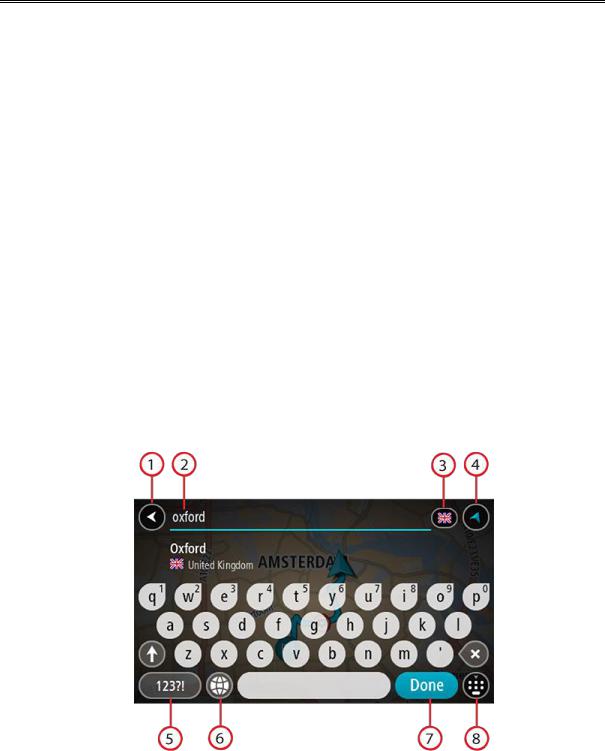
Using step by step search
About search
STEP BY STEP SEARCH ONLY
You use the Drive To menu to find addresses and Points of Interest (POI) and then navigate to them. You must first choose the country or state you want to search in, then enter the address or the POI type or name.
In Address, you can search for the following:
A specific address in a town or city.
A postcode, for example, type in W1D 1LL for Oxford Street, London.
A city to navigate to a city centre, for example, type in London.
In Points of Interest, you can search for the following:
A POI (Point of Interest), for example type in museum. In Latitude Longitude, you can search for the following:
Latitude and longitude coordinates, for example, type in:
N 51°30′31″ W 0°08′34″.
Entering search terms
STEP BY STEP SEARCH ONLY
Select Drive To in the Main Menu, then select Address or Point of Interest. The search screen shows the keyboard and the following buttons:
1.Back button
Select this button to go back to the previous screen.
2.Search input box
25

Enter your search term here. As you type, matching addresses or POIs are shown.
Tip: If you press and hold a letter key on the keyboard, you get access to extra characters if they are available. For example, press and hold the letter "e" to access characters 3 e è é ê ë and more.
Tip: To edit, select a word you have already typed to place the cursor. You can then insert or delete characters.
3.Country or state selector
Select the country or state you want to search.
4.View button
Select this button to return to the map view or guidance view.
5.123?! button
Select this button to use numbers and symbols on your keyboard. Select the =\< button to toggle between the numbers and more symbols. Select the ABC button to go back to the general keyboard.
6.Keyboard layout button
Select this button to change your keyboard layout to another language. You can choose up to four layouts from the list. If you have more than one layout selected, selecting the keyboard layout button opens a pop-up so you can quickly swap between your selected keyboard layouts. Press and hold this button to go directly to the list of all the layouts.
7.Done button
Select this button to hide the keyboard.
8.Show/hide keyboard button
Select this button to show or hide the keyboard.
Tip: Select the Shift key once to make the next letter you type upper case. Double tap the Shift key to use Caps-Lock where all the letters you type are upper case. Select the Shift key once to quit Caps-Lock.
Tip: To cancel a search, select the map/guidance view button in the top right-hand corner of the screen.
Working with search results
STEP BY STEP SEARCH ONLY
Your Address or Point of Interest search results are shown in a list.
Tip: To see more results, hide the keyboard or scroll down the results list.
26
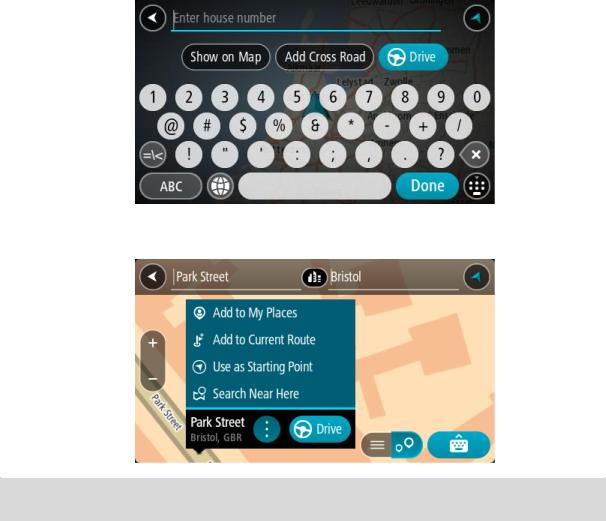
When you select an address from the list of search results, you can choose to show it on the map, add a cross road or plan a route to that chosen location. To get an exact address you can add the house number. When you select a POI from the list of search results, it is shown on the map.
When you show the address or POI on the map, you can use the pop-up menu to add the location to My Places. If a route is already planned, you can add the location to your current route.
Note: The best search results are shown on the map. When you zoom in, the lower ranked search results are gradually shown.
About postcodes
When searching using a postcode, your results depend on the type of postcode used in the country that you are searching in.
The following types of postcodes are used:
Postcodes that navigate you to a street or part of a street.
Postcodes that navigate you to an area comprising, for example, a single town, several villages in a rural area or a district in a large city.
Postcodes for streets
Countries such as the Netherlands and the United Kingdom use this type of postcode. When you search using this type of postcode, enter the postcode, then leave a space and then optionally enter the house number. For example, "1017CT 35". Your device then plans a route to a specific house or building on a specific street.
27
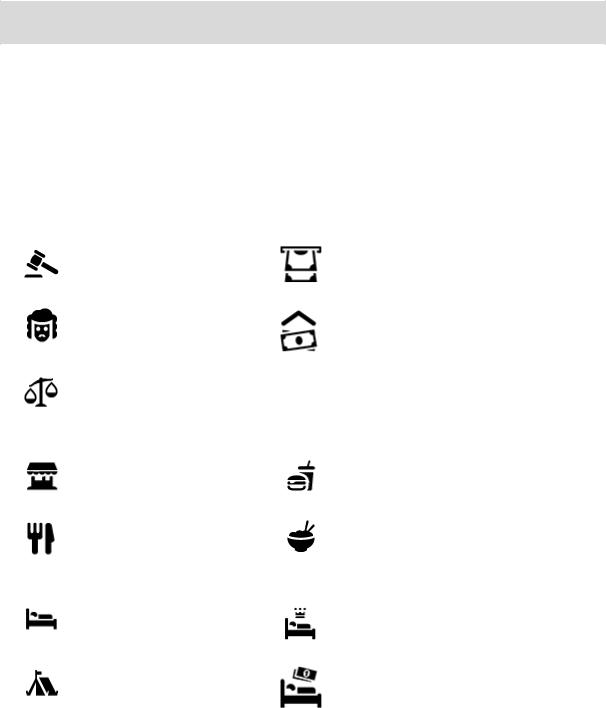
Postcodes for areas
Countries such as Germany, France and Belgium use this type of postcode. If you search using a postcode for an area, your results include all the streets in a city district, the whole town, or the villages within that postcode.
When using quick search, you may get results from multiple countries if you enter a postcode for an area.
Note: If you search using a postcode for an area, you will not get a specific address in your results.
This type of postcode is still very useful in reducing the number of search results. For example, a search for Neustadt in Germany returns a long list of possible results. Adding a space followed by the postcode for an area narrows the results down to the Neustadt that you are looking for.
As another example, if you want to search in a city, enter a postcode for an area and select the city centre you are searching for from the results.
List of POI type icons
Legal and financial services |
|
Court house |
Cash dispenser |
Legal - Solicitors |
Financial institution |
Legal - other services |
|
Food services |
|
Convenience store |
Fast food restaurant |
Restaurant |
Chinese restaurant |
Accommodation |
|
Hotel or motel |
Luxury hotel |
Camping ground |
Economy chain hotel |
Emergency services |
|
28
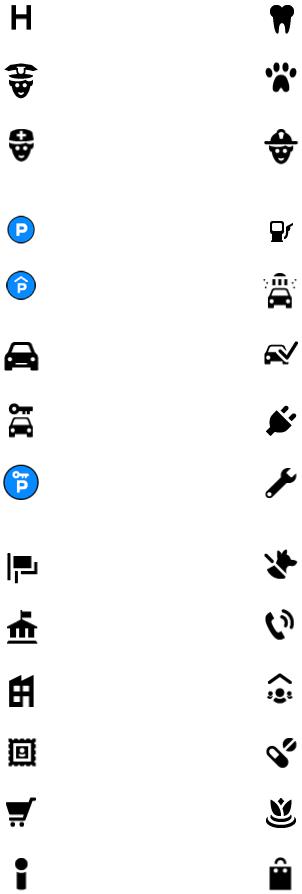
Hospital or polyclinic |
Dentist |
Police station |
Veterinarian |
Doctor |
Fire station |
Car-related services |
|
Outside parking |
Petrol station |
Parking garage |
Car wash |
Car dealer |
Vehicle inspection centre |
Rental car facility |
Electrical car charging |
|
point(s) |
Rental car parking |
Car repair facility |
Other services |
|
Embassy |
Pet services |
Government office |
Telecommunication |
Company |
Community service |
Post office |
Pharmacy |
Shopping centre |
Beauty services |
Tourist information office |
Shop |
|
29 |
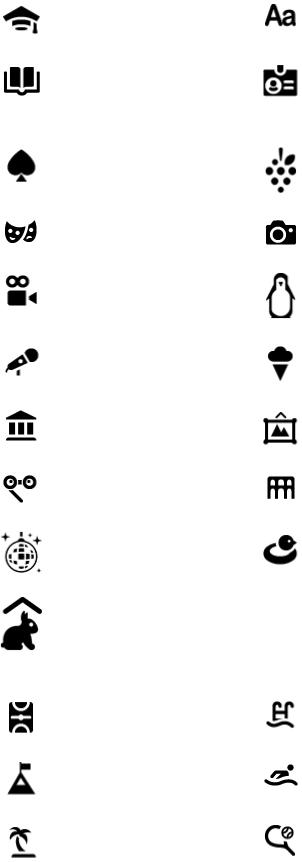
Education |
|
College or university |
School |
Library |
Convention centre |
Leisure |
|
Casino |
Winery |
Theatre |
Tourist attraction |
Cinema |
Zoo |
Concert hall |
Amusement park |
Museum |
Exhibition centre |
Opera |
Cultural centre |
Nightlife |
Leisure centre |
Children's Farm |
|
Sport
Playing field |
Swimming pool |
Mountain peak |
Water sports |
Beach |
Tennis court |
|
30 |
